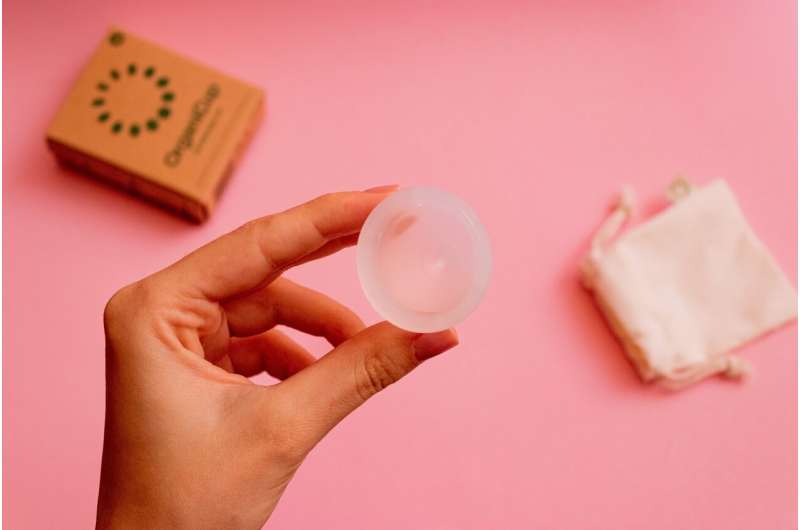This article has been reviewed according to Science X's editorial process and policies. Editors have highlighted the following attributes while ensuring the content's credibility:
fact-checked
trusted source
proofread
Menstrual discs may be best for heavy monthly blood flow

Amid widely differing capacities of available menstrual hygiene products, a menstrual disc—similar in shape to a diaphragm—may be best for dealing with heavy monthly blood flow as well as indicating excessive blood loss, suggests research published online in the journal BMJ Sexual & Reproductive Health.
Despite the fact that 800 million women around the globe will be on their period every day, menstruation remains something of a taboo subject—a stance that has hindered research and transformed a normal bodily process into something that is often associated with stigma and normalization of pain, argue gynecologists in a linked editorial.
Heavy menstrual bleeding affects up to 1 in 3 women. While common, it may be a sign of underlying health problems, such as a bleeding disorder or fibroids, say the researchers.
The Pictorial Blood Loss Assessment Chart (PBAC), based on the type, number, and saturation of menstrual pads and tampons, is used to pick up abnormally heavy blood flow.
But alternative menstrual hygiene products, such as discs, cups, and absorbent pants, which are gaining in popularity, have yet to be included in this chart.
What's more, there's no industry standard for capacity testing except for tampons due to their historical link with risk of toxic shock syndrome. And reported capacity is based on saline or water, neither of which is anything like menstrual blood, add the researchers.
To strengthen the evidence base and help improve diagnostic accuracy, the researchers compared the absorbency/fillable capacity of 21 currently available and commonly used menstrual hygiene products, using human red blood cells.
The products included regular pads from 2 different manufacturers with different reported absorbencies as well as those for postnatal bleeding; same brand tampons of different reported absorbencies; same brand menstrual cups of different sizes; 4 different brands of discs including small and large sizes within the same brand; and 3 pairs of super absorbency period pants (small, medium, and large).
The test results showed that, on average, menstrual discs held the most blood at 61 ml, with one brand (Jiggy) holding 80 ml, which is diagnostic of excessive blood loss; absorbent pants, on average, held the least at 2 ml, irrespective of size.
The perineal cold pack pads—intended for postnatal bleeding—and 1 pair of period pants held just 1 ml each. Tampons, pads, and menstrual cups held similar amounts: 20-50 ml.
Typically, there was a mismatch between reported and actual absorbent capacity. "We also found that the product capacity labeling was discordant with our results—the majority of products reported that they had greater capacity than our testing found. We suspect this is due to product testing with non-blood liquids, such as water or saline," note the researchers.
They acknowledge various limitations to their findings: lab test results aren't the same as those obtained on people. Reasons of comfort and convenience may also prompt women to change their products before saturation, which may overestimate heavy blood flow.
And while red blood cells more closely resemble menstrual blood than either water or saline, they still fall short of the real thing.
But they conclude, "Further understanding of capacity of newer menstrual products can help clinicians better quantify menstrual blood loss, offer diagnostic testing, and accurately treat [heavy menstrual bleeding]."
In a linked editorial, Dr. Paul Blumenthal of Stanford University and colleagues, note that women can expect to have over 400 menstrual cycles in their lifetime.
Yet, "Consistent with women's health research in general, menstruation-focused research has been, and continues to be, underrepresented in the medical literature," they write.
Only one study on menstrual blood was published between 1941 and 1950, with only 400 over the past several decades. This tally compares with around 10,000 studies on erectile dysfunction during the same timeframe, they point out.
We need to have more hard data, they emphasize, because there are a range of financial costs associated with having a period, ranging from the purchase of menstrual hygiene products and painkillers to time off work and school.
Evidence is also beginning to emerge that menstrual blood may shine a diagnostic light on conditions such as endometriosis and diabetes, and the presence of HPV, the virus associated with womb cancer.
"With so many future possibilities for deriving clinical value from menstrual blood, one can almost imagine a future in which menstrual stigma is replaced by clinical opportunity," they suggest.
"A thorough grasp of the complex dynamics of the normal menstrual cycle, coupled with proper use of suitable menstrual products, forms the essential foundation for enhancing quality of life and providing better care for [women]," they conclude.
More information: Red blood cell capacity of modern menstrual products: considerations for assessing heavy menstrual bleeding, BMJ Sexual & Reproductive Health (2023). DOI: 10.1136/bmjsrh-2023-201895





















